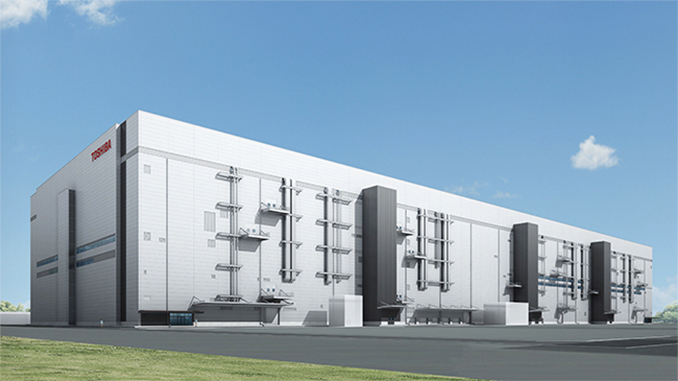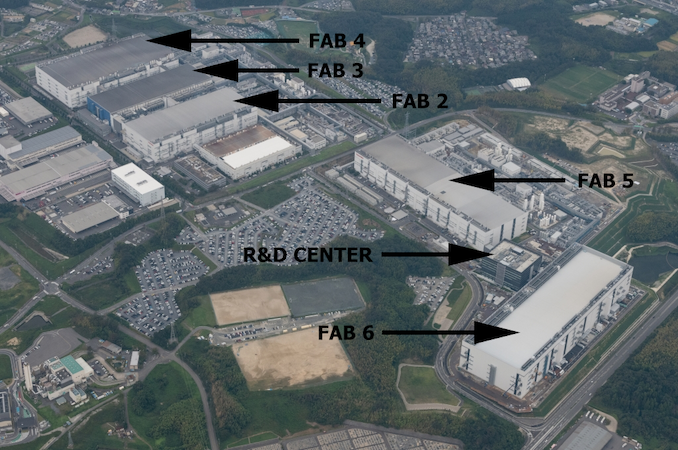Toshiba & WD NAND Production Hit By Power Outage: 6 Exabytes Lost
by Anton Shilov on June 28, 2019 12:15 PM EST
Toshiba Memory and Western Digital on Friday disclosed that an unexpected power outage in the Yokkaichi province in Japan on June 15 affected the manufacturing facilities that are jointly operated. Right now, production facilities are partially halted and they are expected to resume operations only by mid-July.
Western Digital says that the 13-minute power outage impacted wafers that were processed, the facilities, and production equipment. The company indicates that the incident will reduce its NAND flash wafer supply in Q3 by approximately 6 EB (exabytes), which is believed to be about a half of the company’s quarterly supply of NAND. Toshiba does not disclose the impact the outage will have on its NAND wafer supply in the coming months, but confirms that the fabs are partially suspended at the moment. Keeping in mind that Toshiba generally uses more capacity of the fabs than WD, the impact on its supply could be significantly higher than 6 EB with some estimating that it could be as high as ~9 EB.
Both companies are assessing the damage at the moment, so the financial harm of the incident is unclear. Not even counting potential damage to production tools and other equipment used at the fabs, 6 EB of NAND cost a lot of money. Furthermore, analysts from TrendForce believe that a consequence of the outage will be some loss of confidence from clients of both companies, which will have a financial impact as well.
The Yokkaichi Operations campus jointly owned and run by Toshiba and Western Digital produces about 35% of the global NAND output in terms of revenue, according to TrendForce. At present, the manufacturing base has five production facilities (Fab 2, Fab 3, Fab 4, Fab 5, and Fab 6) as well as an R&D center, all of which were affected by the outage. Three fabs within the campus produce 3D NAND flash, whereas another two are used to make special-purpose types of memory.
Considering the gargantuan size of the Yokkaichi Operations, disruptions of its supply will inevitably have an effect on 2D NAND and 3D NAND spot prices in the short-term future. Nonetheless, since contract prices have already been set for Q3 (and possibly Q4), they are not going to change. Meanwhile, it remains to be seen whether large customers will have to go shopping in Q3 or Q4 and affect prices on the spot markets further.
Considering that the Yokkaichi Operations produces at least 1/3 of the global NAND flash output (let’s assume that dollar share more or less corresponds to bit share) and half of its production for the quarter was lost because of the incident, this means that the industry will miss approximately 1/6 (or 16.5%) of the global NAND supply in Q3. Whether or not this will create a deficit on the market that will cause significant price hikes depends on multiple factors and is something that remains to be seen.
Related Reading
- Toshiba Memory and Western Digital Open Fab 6 and New Memory R&D Center
- Toshiba Memory & Western Digital Finalize Fab K1 Investment Agreement
- Toshiba Begins to Construct New BiCS 3D NAND Fab in Iwate Prefecture
- Toshiba Memory to Build New Fab to Produce BiCS 3D NAND
- Toshiba Finalizes Plans for New 3D NAND Fab: Coming Online in 2019
- Toshiba to Build New Fab to Produce BiCS NAND Flash
Sources: Western Digital, Reuters, TrendForce, Blocks & Files












148 Comments
View All Comments
Dragonstongue - Saturday, June 29, 2019 - link
how odd, seems one fab of sorts for memory or nand or storage is being shut/taken down for various reasons and of course "massive amounts of inventory not yet totally accounted for will likely affect all consumers alike"bad luck they say comes in streaks, that should mean wicked great is going to happen as well
(but people are people, and do stupid people things)
so likely it will be just as pricing has finally started to come down most of the folks making this stuff are putting as little out as possible (at higher price) to try to "maintain" status quo (you want this .01c grain of sand, ok, it will cost..... 1000000% more (minimum) likely will break in a year or so
because we saved some of that sand to use on your next .01c grain of sand (which is now .0000001c (shhhhh dont tell anyone)
Kastriot - Sunday, June 30, 2019 - link
Who cares they have dosh, but now we gonna pay their loses.eva02langley - Monday, July 1, 2019 - link
So basically, tomshardware is stating "to decline by six exabytes, or 1 billion gigabytes,"...1 000 000 000 gb X 0.22$ revenu/gb (roughly on amazon retail) = 10 000 000$ of revenue
I don't get it.
eva02langley - Monday, July 1, 2019 - link
Oups... 220 000 000$... post this too fast.Okay, still a nice sum, but I don't believe it is such a disaster.
For SSD nand, we are talking about 100 000 000$ for a 100$ tb drive.
Gunbuster - Monday, July 1, 2019 - link
Not really seeing any traditional backup genset looking gear on google maps view. Is it possible they were so cocksure on power delivery they don't have any? How on earth would you get that approved, its like not building bathrooms...eva02langley - Monday, July 1, 2019 - link
Running a server bank and making silicon are two different things... but only in the world of simpletons such comparison can occurs...Coming from an electric engineer by the way.
Gunbuster - Monday, July 1, 2019 - link
Do tell us oh wise engineer, say you got the contract to build out a fab. Your solution is for a 15 minute power hit is to take it on the nose and burn something like 100 million to half a billion in lost inventory and calibration/restart time? You're telling me a data center can be engineered to have backup battery/genset power with 30kW power density racks but a fab cant? I don't buy that for a second.Ananke - Monday, July 1, 2019 - link
That's why corporation do have insurance contracts - in many many cases having an insurance and allocating the cost of the risk among many payers may be a lot more financially soundly than double or tripple backup - this is not a matter of saving human lives scenario, so the much cheaper insurance path makes more sense. And yes, the end user is part of the insurance cost allocation, essentially.Adramtech - Tuesday, July 2, 2019 - link
Gunbuster, this campus practically needs a power plant for 6 Fab sites at one location. It has to be using more than 500MW. Samsung's largest plant requires 200MWGunbuster - Tuesday, July 2, 2019 - link
So you allocate 5% of your build budget to backup power generation. They always tout fabs costing billions. 5% of your build that's 50 million per building to buy gear to keep your operation up in a disaster scenario. lets say 10 10 megawatt gensets per building. I'd say that's doable on 50 million. And do it per building so you dont have all your eggs for the campus in one basket...